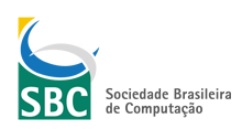Agentes BDI com Percepção Fuzzy na Simulação de um Modelo Presa-Predador Fuzzy
Resumo
The aim of this work is to develop a model of fuzzy perception for BDI agents, with an application in the pray-predator problem, where the process of deciding on which pray a predator should attack, based on the strength of the pray comparing with its own strength, is based on its fuzzy perception. In this environment, there are different types of predator agents, where of them been the BDI agent with fuzzy perception. Several simulations are realized for the comparative evaluation of the different types of predator agents in two types of environments: with and without competition between predators.
Referências
A. Casali, L. Godo, and C. Sierra. Graded BDI models for agent architectures. In Computational Logic in Multiagent Systems, volume 3487 of LNAI, pages 126–143. Springer, Berlin, 2005.
A. Casali, L. Godo, and C. Sierra. Modelos BDI graduados para arquitecturas de agentes. Revista Iberoamericana de Inteligencia Artificial, 9(26):67–75, 2005.
A. Casali, L. Godo, and C. Sierra. Multi-context specification for graded BDI-agent. In C. Ghidini, editor, Doctoral Consortium - Fifth International Conference on Modeling and Using Context (CONTEXT-05), pages 31 – 40, Paris, 2005. LIP 6.
A. Casali, L. Godo, and C. Sierra. Modeling travel assistant agents: a graded BDI approach. In Artificial Intelligence in Theory and Practice, volume 217 of IFIP International Federation for Information Processing, pages 415–424. Springer, Berlin, 2006.
A. P. Cruz. Lógicas BDI fuzzy. Master’s thesis, UFRN, 2008.
F. Cuesta and A. Ollero. Intelligent control of mobile robots with fuzzy perception. In Intelligent Mobile Robot Navigation, volume 16 of Springer Tracts in Advanced Robotics, pages 79–122. Springer, Berlin, 2005.
E. del Acebo and J. L. de la Rosa. A fuzzy system based approach to social modeling in multi-agent systems. In Proc. of Intl. Conf. on Autonomous Agents and Multiagent Systems, pages 463–464. ACM, 2002.
G. P. Dimuro, A. V. Santos, G. P. Bedregal, and A. C. R. Costa. Fuzzy evaluation of social exchanges between personality-based agents. In L. S. Lopes, N. Lau, P. Mariano, and L. M. Rocha, editors, New Trends In Artificial Intelligence, Proc. of 14th Portuguese Conference on Artificial Intelligence, EPIA’2009, pages 451–462, Aveiro, 2009. APIA/Universidade de Aveiro.
G. P. Farias, G. P. Dimuro, and A. C. R. Costa. Um modelo de percepção fuzzy para agentes BDI. In L. A. O. Rocha and S. S. C. Botelho, editors, Proc. of the 3rd Southern Conference on Computational Modeling, pages 254–257, Rio Grande, 2009.
N. Ghasem-Aghaee and T. I. Ören. Towards fuzzy agents with dynamic personality for human behavior simulation. In Proc. of the 2003 Summer Computer Simulation Conference, Montreal, July 20-24, 2003, pages 3–10, San Diego, 2003. SCS.
L. Hai-bo, G. Guo-chang, S. Jing, and F. Yan. AUV fuzzy neural BDI. Journal of Marine Science and Application, 4(3):37–41, 2007.
S. Hassan, L. Garmendia, and J. Pavón. Agentbased social modeling and simulation with fuzzy sets. In E. Corchado, J. M. Corchado, and A. Abraham, editors, Innovations in Hybrid Intelligent Systems, number 44 in Advances in Soft Computing, pages 40–47. Springer, Berlin, 2008.
K. Ishii and M. Sugeno. A model of human evaluation process using fuzzy measure. International Journal of Man-Machine Studies, 22(1):19–38, 1985.
R. S. M. Jafelice, L. C. Barros, and R. C. Bassanezi. Teoria dos Conjuntos Fuzzy com Aplicações. SBMAC, São Carlos, 2005.
P. Lokuge and D. Alahakoon. Decisions based upon multiple values: the BVG agent architecture. In N. R. Pal, Nikola Kasabov, Rajani K. Mudi, Srimanta Pal, and Swapan K. Parui, editors, Neural Information Processing, number 3316 in LNCS, pages 941–946, Berlin, 2004. Springer.
S. A. Long and A. C. Esterline. Fuzzy BDI architecture for social agents. In N. R. Pal, Nikola Kasabov, Rajani K. Mudi, Srimanta Pal, and Swapan K. Parui, editors, Proceedings of the IEEE Southeastcon 2000, pages 68–74, Los Alamitos, 2000. IEEE.
H. Mobahi and S. Ansari. Fuzzy perception, emotion and expression for interactive robots. In Proc. of the IEEE Intl. Conf. on Systems, Man and Cybernetic (SMCC03), volume 4, pages 3918–3923, Washington, 2003.
M. S. Peixoto, L. C. Barros, and R. C. Bassanezi. Predator-prey fuzzy model. Ecological Modelling, 124(1):39–44, 2008.
T. I. Ören and N. Ghasem-Aghaee. Personality representation processable in fuzzy logic for human behavior simulation. In Proc. of the 2003 Summer Computer Simulation Conference, Montreal, July 20-24, 2003, pages 11–18, San Diego, 2003. SCS.
T. J. Ross. Fuzzy Logic with Engineering Applications. Wiley, New Mexico, 2004.
E. Sabeur and G. Denis. Human behavior and social network simulation: Fuzzy sets/logic and agentsbased approach. In Proc. of the 2007 Spring Simulation Multi-Conference, Norfolk, 2007, pages 102–109, San Diego, 2007. SCS.
S. Shen, G. M. P. O’Hare, and R. Collier. Decisionmaking of BDI agents, a fuzzy approach. In Proceedings of The Fourth International Conference on Computer and Information Technology, pages 1022 – 1027, Washington, 2004. IEEE.
S. Shen, G. M. P. O’Hare, and M. J. O’Grady. Fuzzy-set-based decision making through energyaware and utility agents within wireless sensor networks. Artificial Intelligence Review, 27(2-3):165–187, 2008.
M. Wooldridge. Reasoning about Rational Agents. Intelligent Robots and Autonomous Agents. The MIT Press, Cambridge, 2000.
M. Wooldridge. An Introduction to MultiAgent Systems. Wiley, Chichester, 2002.
L. A. Zadeh. Fuzzy sets. Information and Control, 8:338–353, 1965.
L. A. Zadeh. Is there a need for fuzzy logic? Information Sciences, 178(13):2751–2779, 2008.



